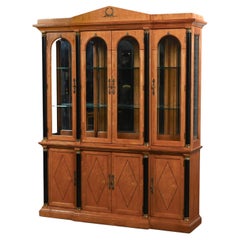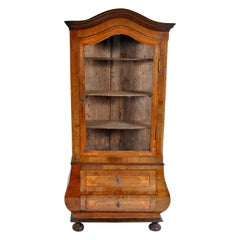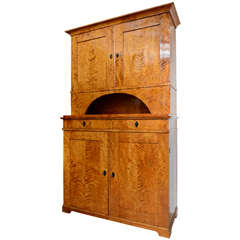Biedermeier Hutch
1995 Biedermeier Style Thomasville Grand Classics Line Breakfront China Hutch
By Thomasville
Located in Topeka, KS
Marvelous vintage 1995 Biedermeier Neoclassic Revival Empire Style Thomasville Grand Classics 2
Category
1990s American Biedermeier Cabinets
Materials
Brass
$6,495
H 87.75 in W 67 in D 16.75 in
Recent Sales
Antique Austrian Biedermeier Bombe Shaped Walnut China Cabinet/Hutch, circa 1840
Located in Portland, OR
Antique Austrian Biedermeier bombe shaped China cabinet/hutch, circa 1840 having an arch shaped top
Category
Antique 1840s Austrian Biedermeier Cabinets
Materials
Walnut
H 74.5 in W 34 in D 15.5 in
Biedermeier Cabinet/ Hutch, Two-part, Flame Birchwood, 19th Century
Located in West Palm Beach, FL
Biedermeier Cabinet/ Hutch, Two-part, Flame Birchwood, ebonized escutcheons, original restored
Category
Antique 19th Century Swedish Biedermeier Cabinets
Materials
Birch
People Also Browsed
Chinoiserie Hollywood Regency 2 Pc China Hutch Cabinet Tamerlane by Thomasville
By Thomasville
Located in Topeka, KS
Handsome vintage Chinoiserie Hollywood Regency Tamerlane Collection 2 Piece China hutch or display cabinet by Thomasville Furniture. Comprised of hardwood, Oriental Holly, and Acacia...
Category
Mid-20th Century American Hollywood Regency Cabinets
Materials
Metal
$3,995
H 76 in W 57 in D 20 in
Hickory White China Cabinet Biedermeier Genesis Collection
By Hickory White
Located in Lake Worth, FL
For FULL item description click on CONTINUE READING at the bottom of this page.
Offering One Of Our Recent Palm Beach Estate Fine Furniture Acquisitions Of A
High-Quality American-M...
Category
Vintage 1980s American Biedermeier Cabinets
Materials
Satinwood, Glass
$2,996 Sale Price
25% Off
H 92 in W 66 in D 19 in
Get Updated with New Arrivals
Save "Biedermeier Hutch", and we’ll notify you when there are new listings in this category.
More Ways To Browse
Arched Hutch
Bombe China Cabinet
Antique Drapers Cabinet
Biedermeier China Cabinet
European Hutch
Thomasville Buffet
Walnut Hutch Antique
Breakfront Hutch
Burl Wood Hutch
Floral Carved Hutch
Vintage Maple China Cabinet
Maple Hutch
Hutch 1920s
1930s Hutch
Swedish Hutch
Black Walnut Hutch
Vintage Maple Hutch
Hutch Kitchen 1920s


